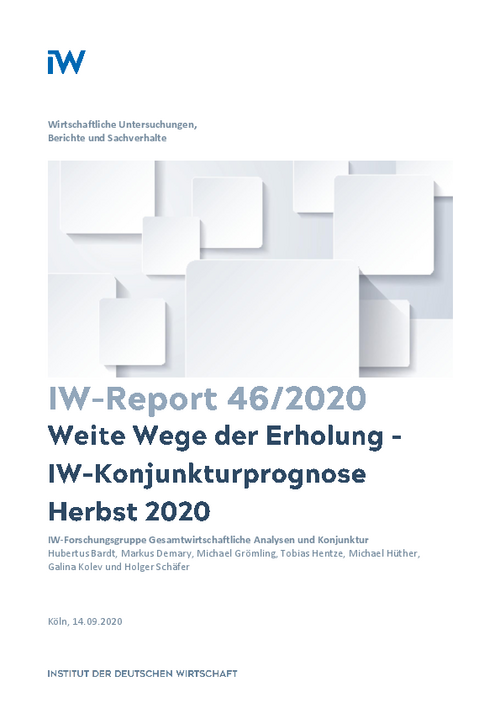In the second quarter of 2020 the corona pandemic adversely affected global economic activity to an extent unparalleled in the last seven decades. This was the result of health policy measures and the virus’s widely varying impact on both the supply and demand sides of the economies it has affected around the world.

IW-Konjunkturprognose: The Long Road to Recovery
IW-Report

In the second quarter of 2020 the corona pandemic adversely affected global economic activity to an extent unparalleled in the last seven decades. This was the result of health policy measures and the virus’s widely varying impact on both the supply and demand sides of the economies it has affected around the world.
However, the subsequent summer months have seen a pronounced economic recovery in many industrialised countries, and especially in China. If this recovery is not interrupted by a further lockdown, global economic activity and world trade may reach pre-crisis levels towards the end of 2021. A vaccine and the easing of geopolitical tensions would firm up and could even improve this overall positive forecast for 2021.
In Germany, exports, capital expenditure on equipment and private consumption slumped sharply in the second quarter of 2020. These aggregates will not have returned to last year’s level by the end of 2021. On the other hand, public sector consumption and the construction industry are providing a positive impetus. In 2020 real GDP in Germany will have declined by 6 ¼ per cent against previous year, while growth of just under 4 ½ per cent is forecast for 2021. The inflation rate will fall to ½ per cent in 2020 while 2021’s consumer prices will be 1 ½ per cent higher than this year’s. The average number of people in work in Germany will fall by ¾ per cent in 2020 but will edge up slightly in 2021. Next year, an annual average of just under 45 million will be in employment, with the number of jobless a little over 2.7 million, corresponding to an unemployment rate of around 6 per cent. The public sector deficit will rise to 200 billion euros this year, around 6 per cent of GDP, with an expected deficit for 2021 of just under 4 per cent. Germany’s public debt ratio will be some 75 per cent of GDP in both years.

IW-Forschungsgruppe Gesamtwirtschaftliche Analysen und Konjunktur / Hubertus Bardt / Markus Demary / Michael Grömling / Tobias Hentze / Michael Hüther / Galina Kolev / Holger Schäfer: Weite Wege der Erholung – IW-Konjunkturprognose Herbst 2020
IW-Report

More on the topic

Effects of the Middle East conflict on the German economy
Beyond the humanitarian crisis associated with the geopolitical conflict in Israel, which affects millions of human lives, the Middle East conflict also leaves lasting marks on economic activity not only in the affected region, but also in Germany and the ...
IW
Corporate Insolvencies on the Increase
After a prolonged decline, the number of corporate insolvencies has begun to rise again. The slight increase in 2022 could be interpreted as a step towards normalisation after the sharp drop experienced during the 2020/21 Covid19 pandemic.
IW